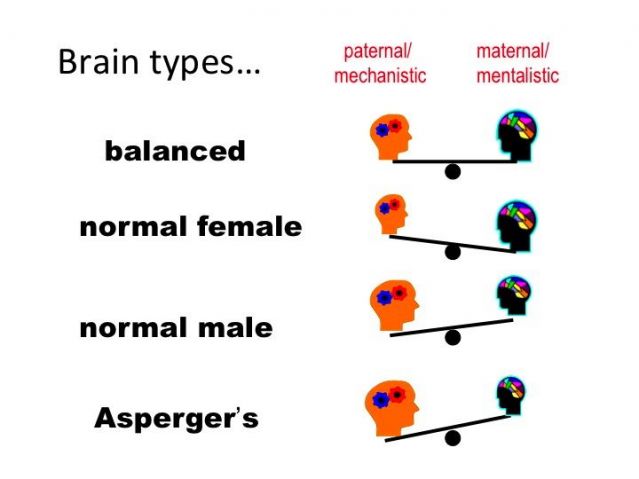Autism
No Extreme Male Brain in Male Autistics
Brain imaging fails to reveal an extreme male brain in autism.
Posted August 19, 2013 Reviewed by Abigail Fagan
Today, the extreme male brain (EMB) theory is the main rival to the imprinted brain theory—at least where explaining autism is concerned. A new study has looked for direct evidence of the effects of biological sex on the neurobiology of autism. The study aimed to answer two principal questions:
- Is the neuroanatomy of autism different in males and females?
- Does the neuroanatomy of autism fit predictions from the EMB theory of autism in males and/or in females?
The study claims to be “the largest sample to date of high-functioning male and female adults with autism, with the aim of answering these two questions by comparing neuroanatomy measured in terms of voxel-based morphometry … a well-established method for observing local volumetric differences in an unbiased whole-brain mass-univariate statistical framework.”
It is, in other words, an attempt to visualize the extreme male brain, and as such a crucial test of the theory. According to the authors:
By examining males and females separately, we found that females with autism had neuroanatomical features that overlapped substantially with sexually dimorphic structures in controls. In males with autism, EMB predictions at the neural level were not confirmed.
The authors go on to offer three different ways in which the EMB might still explain their findings, and then conclude with the consideration of another hypothesis predicting a relationship between autism and biological sexual differentiation: the “gender-incoherence” theory.

The authors do not mention the imprinted brain theory, despite the fact that, where autism is concerned, it comes so close to the EMB. As the visualization above suggests, the imprinted brain theory holds that autism is the outcome of a preponderance in the expression of paternal genes and their associated mechanistic style of cognition during development: not so much an extreme male brain as an extreme paternal one. But of course, because all fathers are male, the two theories are similar. Where they differ is in the very feature not revealed by the new study: namely, the contention that autism goes with an extreme of typical male brain development.
On the contrary, because most paternally-active genes are expressed in both males and females, you cannot say that an enhanced expression of them is the same as typical male development. According to this way of looking at things, it is more a question of enhanced paternal and/or reduced maternal gene expression within a brain that is independently either male or female, inevitably with variable and complex outcomes that allow for far greater subtlety than the crude EMB model.
Furthermore, the imprinted brain theory goes beyond the EMB in proposing that, if autism spectrum disorder (ASD) is the outcome of more paternal and less maternal gene expression, a psychotic spectrum disorder (PSD) such as schizophrenia is the opposite: more maternal and less paternal gene expression with a corresponding preponderance of mentalistic cognition. Moreover, the model proposes that since all mothers are female and all fathers are male, the sexes are slightly offset on the mentalistic continuum: with females being averagely more mentalistic and males being less (with the opposite being the case for mechanistic cognition).
As the diagram suggests, this means that a female Asperger’s case is more different from normal than is a male one, and so it is not surprising that the study did indeed find evidence of brain differences in female Asperger’s cases not apparent in males. This is because the imprinted brain theory, like the EMB, agrees that there are sex differences in normal cognition, and goes on to suggest that the changes in neuro-anatomy that result in high-functioning autism are therefore likely to be greater in females compared to normal females than in males compared to normal males.
What the imprinted brain theory does not predict however but what the EMB crucially does, is that male autistics should show an extreme of male development in this respect. And this study shows that this is indeed the case: they don't.
Of course, the imprinted brain theory also predicts the exact opposite in PSD: apparent feminization of the brain in male psychotics, but not necessarily in females. As I point out in The Imprinted Brain, oestrogen plays a protective role in female brain development before birth, and contributes to a less severe course and expression of schizophrenia in women than in men. Furthermore, feminizations and/or de-masculinization of males by sex steroid hormones has been suggested as a possible predisposing factor to male schizophrenia, while others note that in terms of neuro-development, schizophrenic men show evidence of feminization (p. 176).
Finally, as I also show at length in that book, this is probably the key to the most bizarre psychotic symptom of the most famous of all psychotics: Schreber’s belief that he was turning into a woman. “Gender-incoherence” indeed—and certainly not in an autistic!


